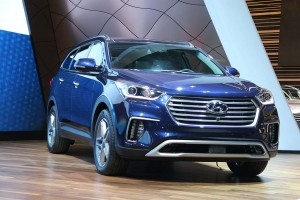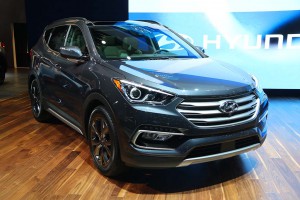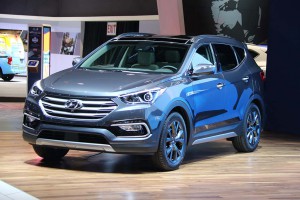
Hyundai makes a number of changes to the 2017 Santa Fe line, including a new front fascia with a brushed-look grille and new headlamps.
By the millions, American motorists are migrating from conventional passenger cars to sport-utility vehicles and more car-like crossover models. And manufacturers are responding with a flood of new offerings.
So, it’s a challenge to keep existing models fresh and competitive – something Hyundai hopes to handle with the debut of updated versions of two key entries at the Chicago Auto Show. It boasts that the 2017 Santa Fe and smaller Santa Fe Sport models get not only a mid-cycle facelift but enhanced safety, convenience and connectivity features.
Hyundai is so upbeat about the prospects for the 2017 updates it is planning to boost capacity, notably adding production of the Santa Fe Sport at its manufacturing plant in Montgomery, Alabama. But it is also readying a slew of new utility vehicles to take advantage of shifting market trends.
(Click Here for complete coverage of the 2016 Chicago Auto Show.)
Visually, the two versions of the Santa Fe will get a new front fascia with a brushed-look grille and new headlamps. The rear fascia has also been updated for 2017, with new taillights and revised dual exhaust. LED daytime running lights will be available for both the Hyundai Santa Fe and Santa Fe Sport, while LED foglights will be an option for the three-row model only.
Under the hood, the engine options are unchanged. For the Santa Fe, buyers will get the 290 horsepower 3.3-liter Theta V-6. The two-row Sport will offer a choice of either a 185 hp 2.4-liter four or a 240 hp turbocharged 2.0-liter four.
But there’s also a new driver-selectable drive mode system that can be shifted to Sport, Eco and Normal Modes. Active Cruise Control is now available, as is a fuel-saving Stop/Start system.
(Hyundai set to launch first pickup, flood of new SUVs. For more, Click Here.)
Even without Stop/Start, mileage is going up about 1 mpg across the board with the Santa Fe Sport, Hyundai notes. The base, front-drive version with the 2.4-liter engine will get 21 mpg City, 27 Highway and 24 Combined.
Interior changes include a 7-inch touchscreen with built-in navigation and Android Auto that becomes standard on the Santa Fe, while it will be an option on the Hyundai Santa Fe Sport. Other infotainment options include the premium Infinity audio system and next-generation Hyundai Blue Link telematics package.
Visually, buyers will likely notice a new center stack, revised instrument panel materials and the optional new power seat package.
Automakers have been racing to include new digital safety technology, and Hyundai is no exception. The two versions of the Santa Fe will now offer such features as forward collision warning with pedestrian detection and autonomous emergency braking; lane departure warning and dynamic bending lights. There’s also a multi-camera view system.
Hyundai is shooting for a NHTSA five-star crash rating, and an IIHS Top Safety Pick+ award.
Pricing for the 2017 Hyundai Santa Fe Sport will start at $25,350 plus delivery fees, with the all-wheel-drive Ultimate package set at $38,250. For the three-row Hyundai Santa Fe, the base model begins at $30,800, and the MSRP on the AWD Ultimate comes in at $41,150.
The Santa Fe model is just arriving at U.S. showrooms, the Sport to follow.
(Click Here for a first drive of the 2017 Hyundai Elantra.)


